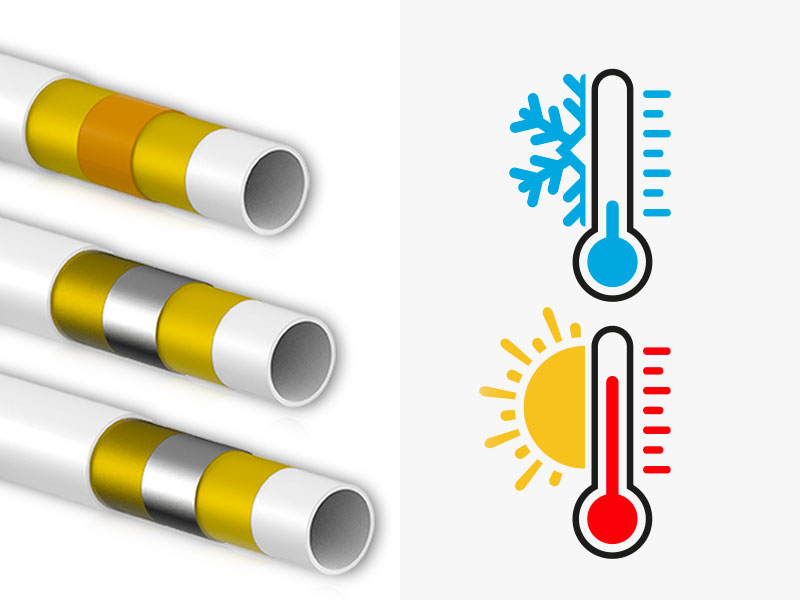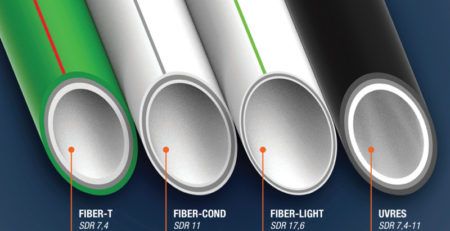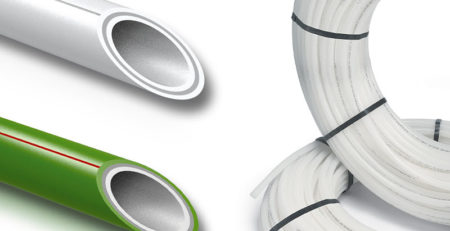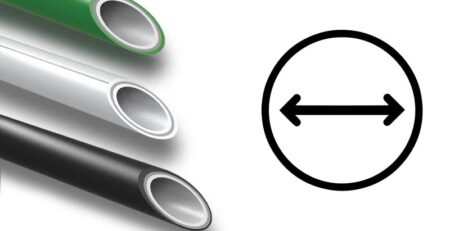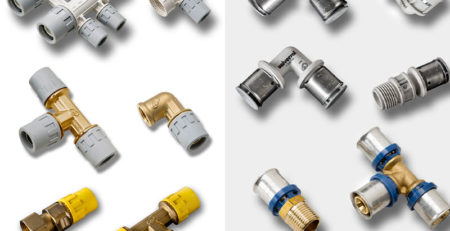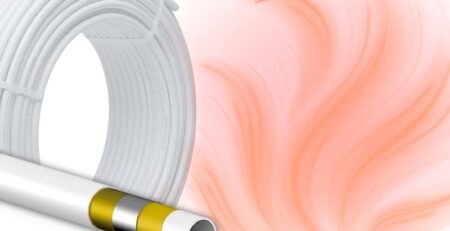Multilayer pipes: maximum temperatures and resistance to cold
Designing a safe pipe system, compliant and efficient starts with the choice of the right product for the project. Suitable pipes will contribute to an increase of energy efficiency of the building, reducing management costs to a minimum and offering to the final user a more comfortable environment. Among the factors to consider there are also temperatures that the pipe can handle and its resistance to cold.
Multilayer pipes for heating and hydro sanitary systems, including potable ones, are a versatile option that combines the benefits of metallic and polymeric materials, for an unparalleled resistance in any field of use.
Multilayer pipes by Aquatechnik: the winning stratification plastic-metal
A multilayer pipe is made of three different layers jointed by two layers of adhesive that combine the strengths of metal with those of plastic materials. This product was born, as a matter of fact, to satisfy the requirements of designers and installers by bypassing the lack of raw materials, for a result that guarantees high resistance and performances.
Multilayer pipes by Aquatechnik are realised with a particular technique of extrusion, starting with the internal layer of the pipe that is created in the first phase merging cross-linked polyethylene together with additives and catalysts. The second extruder applies an adhesive layer and later an aluminium layer. After the perfect calibration of the latter, TIG sealing allows uniformity of thickness along the pipe circumference and in the point of sealing. Subsequently the third extruder covers the aluminium layer with adhesive to attach the final layer of cross-linked polyethylene.
The stratification PE-Xb/Al/PE-Xb grants notable advantages to Aquatechnik multilayer pipes: it is resistant to corrosion, hygienic and not permeable to oxygen and light. It has a reduced thermal expansion compared to the majority of plastic materials and keeps heat thanks to its composition. It offers a resistant and long-lasting system like metal pipes but is lighter and more flexible. It is a winning combination that not only guarantees an efficient installation but overcomes many specific challenges of the materials that could cause great costs or malfunctions to the system.
Features of resistance: the temperatures of multilayers
Multi-calor by Aquatechnik has an expected life of at least 50 years at pressure of 10 bar and continuous temperature of 70°C with peaks of 95°C, as requested by the norm UNI EN 21003. For temperatures inferior to 95°C, pipes can resist to pressures superior to 10 bar, keeping a very high degree of reliability over time and increasing their expected life.
In case of extreme weather conditions, multi-calor multilayer pipes by Aquatechnik can work up to minimum temperatures of -45°C. For employment below 0°C, it is necessary to use anti-freezing or glycol additives.
Multi-calor pipes working conditions are shown in the table below:

Multi-eco pipes are distinguished from the previous products for their external layer made of PE-HD, keeping the same composition for the intermediate aluminium layer and the inner layer made of PE-X which touches the fluid.
The maximum working temperature of multi-eco is 95°C at constant use, with peaks of 100°C, while minimum temperature is the same as multi-calor pipes at -45°C
Working conditions of multi-calor pipes are shown in the table below:

Multi-calor pipes are certified for all 4 classes of application for the aforementioned international norm UNI EN 21003 for pressures up to 10 bar.

Polipert multilayer pipes have a different composition. They have five synergetic layers: the inner and external layer are in polyethylene with higher resistance to temperatures. Between them a EVOH layer is extruded which functions as a barrier against oxygen. The adherence between layers is possible thanks to special adhesives. These pipes are not suitable to convey potable water, differently from multi-calor and multi-eco. They are, on the other hand, ideal for the realisation of radiant floor systems and for heating at low temperatures. The maximum temperature at continuous use for Polipert is 70°C and, according to the ISO 22391 norm, it can be used in 4 classes of applications:

The working conditions of Polipert depending on diameter are shown in the table below:

Both multi-calor and multi-eco pipes are available in pre-isolated version for heating and hydro sanitary systems at high temperatures for energy containment. The isoline version of both pipes has a coating of closed cell expanded polyethylene with a resistance factor against diffusion of steam of around 5000 µ and thermal conductivity particularly low of λ=0,040 W/mk. Multi-calor pipes are also available in isoline plus, which coating has a thermal conductivity λ equal to 0,035 W/mk.
Resistance to cold of multilayer pipes made of PE-X
Cross-linked polyethylene (PE-X) is a modified material in the molecular structure through the formation of lateral chemical links in the polymeric chains. Crosslinking allows to improve performances, among them, as we saw, resistance to high temperatures, chemical resistance and resistance to abrasion. The intrinsic flexibility of cross-linked polyethylene grants also excellent resistance to ruptures from freezing. This means that if water or other fluids freeze inside PE-X pipes, the elasticity of the material allows, withing certain limits, to expand without bending or breaking and to reset to the original diameter after defreezing.
There are variables in an installation that can cause a breakdown of PE-X in certain situations. When they are installed outside a building there must be adequate thermal insulation to avoid the formation of ice. How much isolation or anti freezing that is necessary to guarantee adequate protection depends on location and climate zone. Moreover, local building norms and regulations are applied. To consider, in designing, also that properties of materials of multilayer pipes with PE-X offer advantages when exposed to freezing conditions, thanks to a thermal conductivity inferior to that of metal materials, which reduces the index of thermal exchange and can increase the time necessary to freeze the fluid inside the system.
The challenges for the hydrothermal sanitary sector with multilayer pipes
Offering the best of pipes among polymeric and metal materials, a multilayer pipe is the perfect answer to the demands of designers and installers that search for performing and efficient solutions. With applications in any sector, from the civilian to the industrial and tertiary, multi-calor, multi-eco and polipert are suited to be installed free pose and inside walls. The wide range of safety fittings for multilayer pipes completes the offer of Aquatechnik to satisfy the market demands in a synergy of resistance and flexibility in any working condition of a system.


